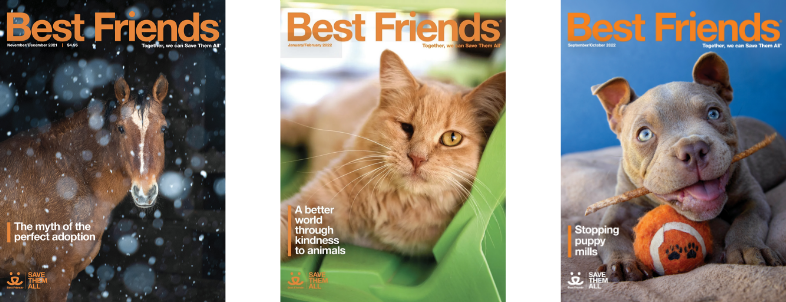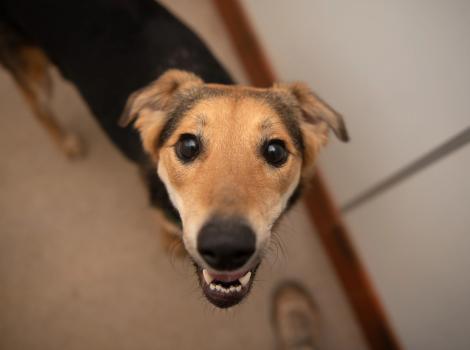The other founders of Best Friends Animal Society

2024 marks the 40th anniversary of Best Friends Animal Society. As someone who has been here since the beginning, that seems both unfathomable to me and just right, all at the same time. Internally, there’s a lot of talk about the founders of Best Friends and the stories that mark the various eras of our journey. The narrative around the founders is essential in memorializing and sustaining the culture of the organization. Consequently, like an old rock group reprising our greatest hits, panel discussions and presentations by surviving founders are a piece of most staff retreats and donor events. There’s a lot of “walking uphill in the snow in both directions,” but there is also a lot of valuable information about values and Best Friends’ North Star illustrated in the stories of watershed moments — about the decisions we made and why.
But as I reflect on our history, something has been missing in our origin stories, and while they are sometimes referenced in passing, they don’t get the airtime they deserve. Those are the stories of the foundational animals who were truly co-creators of Best Friends along with those of us designated as founders. Best Friends would not look, feel, or be like what it has become without the very real contributions of the animals around whom we built the Sanctuary.
As you drive around the Sanctuary, you will see roads and buildings named for dogs and cats, each of whom marked an era or an event in our timeline or who had such outsized personalities that the story of Best Friends can’t be fully told without including them. There’s Bertrand Road, Gandolph Loop, Benton Street, Amra and Rhonda’s Octagon in Dogtown Heights, Ginger’s Place, Julius Street, Tomato Lane, and many others. I’d like to share a few of my recollections of them.
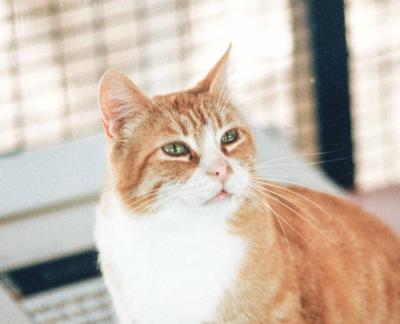
Early residents of Dogtown
Co-founder Faith Maloney liked to recount an epiphany she had early in her long tenure as the head of Dogtown. One day, having completed the first of her daily tasks (feeding hundreds of dogs with the help of her daughter Carragh, Tyson Horne, and a volunteer or two), she looked out over her domain and realized that it wasn’t her domain at all! It belonged to the dogs. It was their little town, complete with a social structure and acknowledged roles of their design and choosing. Faith picked up on what had unfolded and began identifying the various roles and relationships. That was the beginning of Dogtown.
In those early days, many of the 500 or so canine residents were what we called “Out Dogs,” meaning they spent their days outside their assigned enclosures and formed a community of several groups who hung out in their own areas or who tagged along behind Faith, Tyson, or Carragh.
Ginger, a sweet Chesapeake Bay retriever from a local backyard breeder who was shut down for inhumane conditions, had the endearing habit of retrieving every yellow tennis ball in Dogtown (there were a lot) and stashing them under a tree at the north end of Dogtown. This sea of fuzzy yellow balls was Ginger’s pride and joy and was identified as Chesapeake Bay on maps of the day.
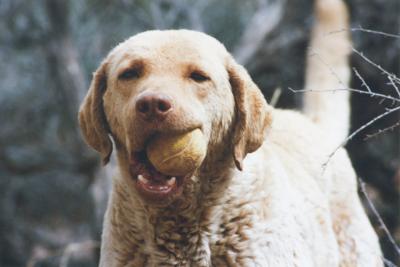
Amra, a 145-pound red malamute who simply turned up one morning, was the head honcho of this little enclave. He had obviously been dumped at the Sanctuary with no local claimants. With his amiable disposition devoid of any apparent stress, he just ambled up to the first person he saw and made himself at home. That person, an avid comic book fan, named the big red dog Amra, the nom de guerre of Conan the Barbarian.
Faith identified Amra as the Sheriff of Dogtown, a badge he wore with distinction for his entire life at Best Friends. He was respected by all the various groups of Out Dogs, and with his imposing size and calm demeanor, Amra truly kept the peace. He was also the official greeter at Dogtown. You hadn’t really been welcomed to Best Friends until Amra approached you with his tail wagging slowly and a big smile on his face; he would then lower his head and almost lift you off the ground.
Amra could cross all the territorial lines without being challenged — except the one that marked the boundary of Victorville, the territory of Victor, the Dog Father of Dogtown. He was a grizzled older dog who, along with his little gang, occupied a shady triangle of trees not far from Chesapeake Bay. They kept to themselves but kept everyone else out of Victorville.
[Digging deep: 35 things you probably don’t know about Best Friends]
Victor was not very large, and he was not a fighter. But his confidence and ownership of that little parcel drew respect from all, including the mighty Amra. No one crossed that imaginary line in the sand. All dogs took the long way around to wherever it was they were headed if the direct route meant crossing that line. It was a fascinating study in social dynamics. Such was Victor’s mystique that even after his passing, Amra would not go into Victorville.
And then there was Rhonda, a small redhead with short wiry hair. She wasn’t very friendly and didn’t really trust people. No one knew where she came from — maybe a dancehall girl who never looked back. Anyway, Rhonda attached herself to Sheriff Amra and never left his side. Theirs was a classic love story. She always had his back, and they trusted each other totally.
When Amra passed, Rhonda mourned terribly and keened like an Irish widow at a funeral. She was inconsolable and lost without Amra. A disconsolate Rhonda was more than anyone could bear. Faith worked to quickly find a home for her with a volunteer from the East Coast who loved and admired both Amra and Rhonda. The little redhead was able to live out her few remaining years on a couch with someone who had known her for a long time.
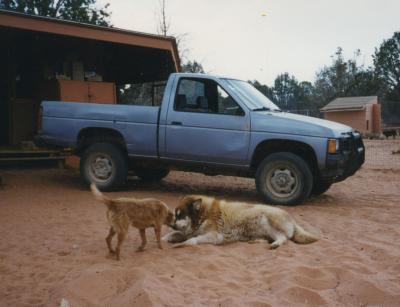
The star of Cat World
Meanwhile, over at Cat World, the emerging star of the show was Tomato. He and his brother arrived as kittens with a very nasty upper respiratory infection (URI) that developed into chronic sinusitis. URI was rampant among the many community cats who came to the Sanctuary from out-of-control colonies of what were known locally as “woodpile cats.”
When we first approached the mayor of Kanab about taking on animal control shortly after we arrived in Angel Canyon, we figured how bad can it be? It’s a tiny town. So Faith became the unpaid, unofficial animal control officer for Kanab, Kane County, and Garfield County in Utah; the town of Fredonia, Arizona; and the Kaibab Paiute Tribe in Arizona. Faith and the team responded to every animal issue in each of these jurisdictions. One memorable call started as a request to remove a few cats from under a double-wide trailer in Kanab. By the time we finished, we had trapped 65 cats from a single colony. Yup, it was bad.
To manage the spread of URI, a common sinus infection caused by one or more viral or bacterial agents, we set up our first isolation unit. Tomato was one of its original occupants. Usually, URI resolves itself in a few weeks with antibiotic support. When it doesn’t, it can become chronic sinusitis, a long-term condition that results in the affected cat blowing nasty boogers randomly around the room.
[The evolution of Best Friends Animal Society]
That was Tomato. Those symptoms, along with his need for ongoing care, made him a difficult candidate for adoption in the era when most of our adoptions were done via off-site events in Las Vegas and Salt Lake City. Tomato was never quite ready for showtime, but his affectionate nature and infectious personality (no pun intended) made him a favorite in Cat World and brought him to the attention of co-founder Michael Mountain, who was then the editor of this magazine. Michael decided to give Tomato his own gossip column in the magazine and assigned Tammy the greyhound as his roving reporter to fetch the juiciest tidbits from around the Sanctuary.
In his column, Tomato liked to vent his disgust at having to take “yucky medicine for his sneezles,” but he never let his personal problems get in the way of a good story. He did tend to get confused, however, about the meaning of words because of his limited worldview and assumption that most things could be understood from the perspective of a kitty living in Cat World. Visitors to Tomato’s office could usually find him or one of his mates sitting on his IBM Selectric typewriter.
Tomato wasn’t just a legend in his own mind. His work also caught the eye of the Pulitzer Prize Board, and in August 2000 he was awarded a Pulitzer Prize. The award letter stated that it was for a new category: “the Purr Prize for service to man’s best friends.” Strange but true.
As an animal lover yourself, you already know that every animal has a story. It sounds simple, but those animals who were at the Sanctuary 40 years ago helped to keep us centered around the tenet that every animal is an individual with a unique personality and needs — and a life that’s worth saving. Every animal who was or is a resident at Best Friends is an essential part of our story. It’s because of them that we do the work we do for animals everywhere.
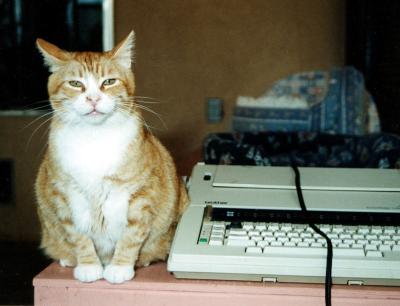
This article was originally published in the January/February 2024 issue of Best Friends magazine. Want more good news? Become a member and get stories like this six times a year.
Let's make every shelter and every community no-kill by 2025
Our goal at Best Friends is to support all animal shelters in the U.S. in reaching no-kill by 2025. No-kill means saving every dog and cat in a shelter who can be saved, accounting for community safety and good quality of life for pets.
Shelter staff can’t do it alone. Saving animals in shelters is everyone’s responsibility, and it takes support and participation from the community. No-kill is possible when we work together thoughtfully, honestly, and collaboratively.
